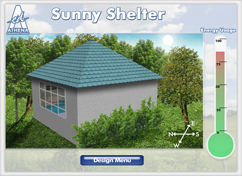Sunny Shelter

Imagine that you're an architect and an environmentally conscious client just asked you to design a home that would use less energy from fossil fuels for heating during the winter season. In order to present the best design, you must first research all of the factors that go into making this house more energy efficient. You can select combinations of features to determine the impact they have on the amount of energy used in the home. Can you create the an energy-efficient home design to impress your client?
Where does Earth's energy come from?
Most of the energy that drives the Earth system comes from the sun. The sun emits energy in the form of electromagnetic radiation. This radiation travels through empty space, sometimes being intercepted by Earth's atmosphere. Visible light is one form of electromagnetic radiation that is capable of reaching Earth's surface. When it interacts with materials, the energy that is absorbed can result in a temperature change.How does energy move from one place to another?
Energy on Earth can be transferred from one place to another by one of three methods: radiation, conduction, or convection. An example of radiation is the energy that travels from the sun through space to Earth's surface. Conduction occurs when thermal energy is transferred between two objects that have physical contact with each other. Convection is when warm air moves in where cold air is and warms up the cold air. All three types of energy transfer must be taken into consideration when planning an energy efficient home. Radiation from the sun is used as a heat source, while heat transfer via conduction or convection can ensure that energy is efficiently moved all throughout the house.How does the sun's radiation interact with materials?
Materials called insulators can block the energy transfer. Insulators are used in homes as a way to prevent heat from entering the house during the summer or leaving the house during the winter. A home insulating material is rated by its thermal resistance, or R-value. A material with a high R-value will prevent more heat transfer than a material with a low R-value. Some materials have the ability to absorb energy and release it at a later time. This is useful in that the material can be heated during the day, but at night when the air temperature drops, the energy stored in the material will transfer to the air warming it up. These materials are said to have a high thermal mass (TM, for short).What is a "green" home?
A "green" home refers to a home that was built to using techniques or materials that reduces its impact on the environment. Typically, these homes are environmentally friendly because they conserve energy and water. Green homes often make use of recycled building materials even further reducing its environmental impact.What are some ways that a person can reduce his impact on the environment?
One important way that you can reduce your impact on the environment is to conserve energy. By using less energy to heat and cool a home or power electrical appliances, you are indirectly reducing the amount of fossil fuels that have to be used. In most power plants, coal is used to generate electricity. Because coal is a limited resource, we risk the danger of it eventually running out. Also, the burning of coal adds pollutants to the atmosphere, which can add sulfur dioxide and carbon dioxide leading to acid rain and global warming. You can also conserve water. Fresh drinking water makes up less than 1% of the available water on Earth, so it is important to conserve it. Additionally, you can reduce your impact on the environment by recycling, and using alternative energy resources.Walkthrough
You need to log in to access this simulation.



